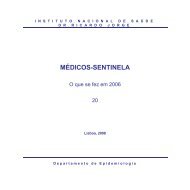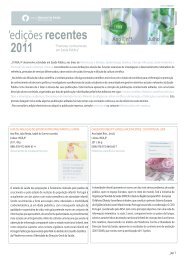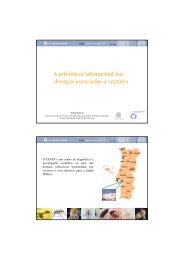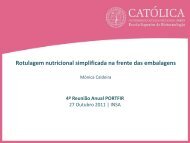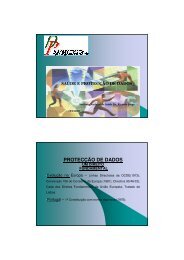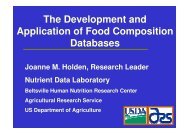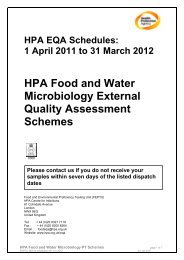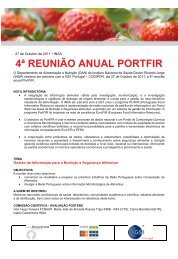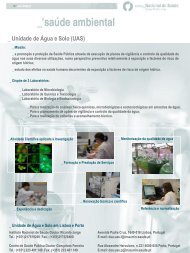European Society of Mycobacteriology - Instituto Nacional de Saúde ...
European Society of Mycobacteriology - Instituto Nacional de Saúde ...
European Society of Mycobacteriology - Instituto Nacional de Saúde ...
You also want an ePaper? Increase the reach of your titles
YUMPU automatically turns print PDFs into web optimized ePapers that Google loves.
SCREENING OF MOLECULES WITH ANTI-TB ACTIVITY, FROM THE BRAZILIAN<br />
CERRADO PLANTS, AND SYNTHETIC METALLO-ORGANIC COMPOUNDS<br />
GL-13<br />
Clarice Leite<br />
Universida<strong>de</strong> Estadual Paulista, Faculda<strong>de</strong> <strong>de</strong> Ciências Farmacêuticas<br />
Worldwi<strong>de</strong>, tuberculosis (TB) remains the most frequent and important infectious disease causing morbidity and <strong>de</strong>ath.<br />
Among all countries in the Americas, Brazil reports the second-highest TB mortality and morbidity, comprising a prevalence<br />
<strong>of</strong> 62/100.000. The global resurgence <strong>of</strong> TB and the rapid emergence <strong>of</strong> MDR-TB, un<strong>de</strong>rscore the importance <strong>of</strong><br />
the <strong>de</strong>velopment <strong>of</strong> new antituberculous drugs.<br />
Plants have provi<strong>de</strong>d many drugs in the past, and they remain a rich source <strong>of</strong> novel compounds. Plant extracts are among<br />
the most attractive sources for <strong>de</strong>veloping new drugs and have been shown to produce promising results in the treatment<br />
<strong>of</strong> several diseases. Our research group <strong>de</strong>als in projects that integrate the chemical and anti-TB activity <strong>of</strong> plants<br />
that compose the bioma <strong>of</strong> the Brazilian Cerrado, a savannah like vegetation. Many <strong>of</strong> those plants are commonly used<br />
as natural remedies by people living in these areas to treat many illnesses. To perform the phytochemical step we used<br />
chromatographic techniques, and to <strong>de</strong>termine the structure <strong>of</strong> the isolated compounds we used mainly spectrometric<br />
methods. To evaluate the activity <strong>of</strong> the extracts, enriched fractions and pure substances against M. tuberculosis we use<br />
the resazurin microtiter assay (REMA) and M. tuberculosis H 37<br />
Rv ATCC 27294 strain. In total were studied 77 extracts<br />
from 39 plants, distributed into 20 families. From all extracts assayed 23% showed promising activity, bellow or equal to<br />
125 µg/mL. The triterpene bassic acid from B. fagifolia showed strong antitubercular activity with MIC values <strong>of</strong> 2.5 µg/mL<br />
comparable to MICs <strong>of</strong> some first-line tuberculosis drugs. The results indicated that plants <strong>of</strong> "cerrado" present fractions<br />
and compounds with promising anti tuberculosis activity.<br />
By the way, the use <strong>of</strong> natural compounds from plants is problematic, due to difficulty in obtaining pure substances and<br />
their low availability.<br />
Within the pipeline <strong>of</strong> new synthetic compounds with potential effectiveness in the treatment <strong>of</strong> TB, there are 7 novel<br />
compounds, which are in various stages <strong>of</strong> clinical <strong>de</strong>velopment. Insi<strong>de</strong> this group however, there are complexes that<br />
associate metals to organic compounds. Using the thiosemicarbazones, semicarbazones and hidrazones <strong>de</strong>rivates as ligands,<br />
we proposed the complexation with Vanadium, to obtain organo-metallic compounds. We <strong>de</strong>termined the anti-M.<br />
tuberculosis activity <strong>of</strong> these compounds using REMA and the study <strong>of</strong> the citotoxicity <strong>of</strong> the ligands and complexes was<br />
performed using murine macrophage cell line J774. We analyzed 37 compounds (14 free ligands and 23 vanadium complexes)<br />
and from <strong>of</strong> this, 17 (46%) presented promising MIC values varying between 0.97 and 7.80 μg/mL. The vanadium<br />
complexes <strong>of</strong> hydrazones, semicarbazones and tiossemicarbazones <strong>de</strong>rivates showed high antiTB activity, most <strong>of</strong> the<br />
time this activity was increased from 2 to 10 times when compared with the free ligands. However due to high citotoxicity<br />
<strong>of</strong> hydrazones, semicarbazones and tiossemicarbazones <strong>de</strong>rivates, the increase in the activity <strong>of</strong> the complexes didn’t<br />
compensate the citotoxicity <strong>of</strong> the ligands.<br />
38 ESM 2009



